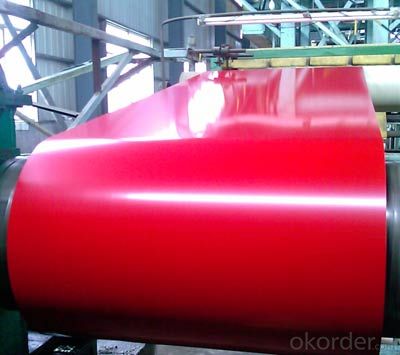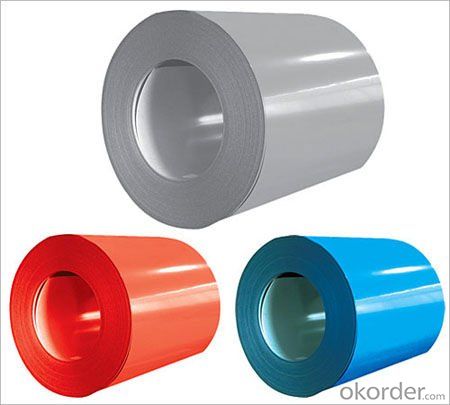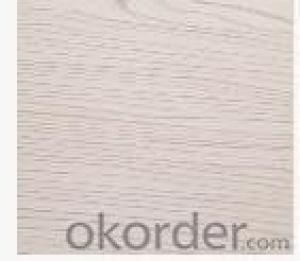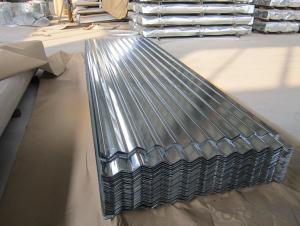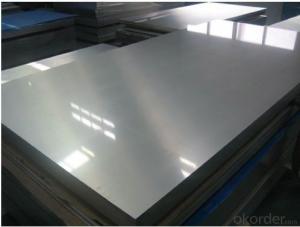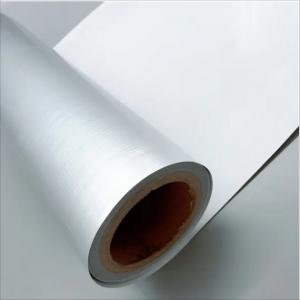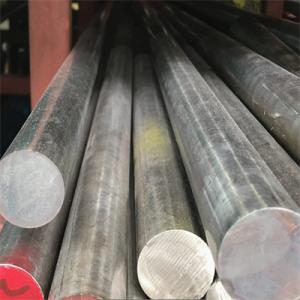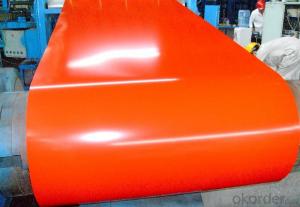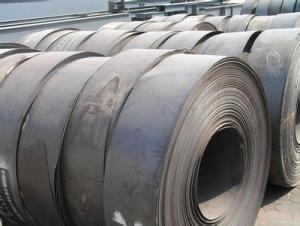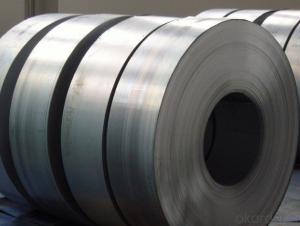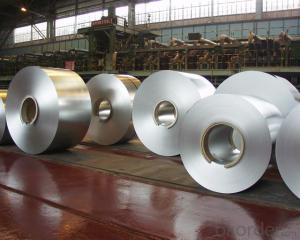Red Flat Metal Strips - Pre-Painted Galvanized/Aluzinc Steel Sheet Coil with Prime Quality and Lowest Price
- Loading Port:
- Shanghai
- Payment Terms:
- TT OR LC
- Min Order Qty:
- 100 m.t.
- Supply Capability:
- 10000 m.t./month
OKorder Service Pledge
OKorder Financial Service
You Might Also Like
1.Structure of Pre-painted Galvanized/Aluzinc Steel Coil Description
With GI (aluzinc) as base metal, after pretreatment (degrease and chemical treatment) and liquid dope with several layers of color, then after firing and cooling, finally the plate steel is called pre-painted galvanized (aluzinc) steel. Pre-painted galvanized steel is good capable of decoration, molding, corrosion resistance. It generally displays workability, durability and weather resistance.
2.Main Features of the Pre-painted Galvanized/Aluzinc Steel Coil
• Excellent corrosion resistance
• Excellent weather resistance
• Capability of decoration, molding, corrosion resistance
• Workability, durability
• Excellent heat resistance performance
• High strength
• Good formability
• Good visual effect
3.Pre-painted Galvanized/Aluzinc Steel Coil Images

4.Pre-painted Galvanized/Aluzinc Steel Coil Specification
Quality standar: JIS G3312 CGCC & CGLCC
Hardness of P: Both soft and hard quality are available
Surface finish: with or without protect film
Thickness : 0.14-1.20 mm
Width : 914mm, 1000mm, 1220mm and 1250mm, thickness 600-1250mm is available
Finish by coil or sheet: Both sheet and coil are available
8Zinc coating: 60-275G/M2, both sides
Paint thickness for top side : 5 micron primer + (10-20) microns modified polyester, blue color code.
Paint thickness for back side: (5-10) microns Epoxy
Weight per coil: 4-6 tons, also can be upon customer's requirements
Max loading weight in one 20ft container : 25 tons generally
5. FAQ of Pre-painted Galvanized/Aluzinc Steel Coil
We have organized several common questions for our clients,may help you sincerely:
1. What is the minimum order quantity ?
Our MOQ is 50mt for each size. And we will consider to give more discount if you make big order like 1000 tons and more. Further more, the more appropriate payment term your offer the better price we can provide.
2. How long can we receive the product after purchase?
Usually within thirty working days after receiving buyer’s advance payment or LC. We will arrange the factory manufacturing as soon as possible. The cargo readiness usually takes 15-25 days, but the shipment will depend on the vessel situation.
3. How to guarantee the quality of the products?
We have established the international advanced quality management system,every link from raw material to final product we have strict quality test;We resolutely put an end to unqualified products flowing into the market. At the same time, we will provide necessary follow-up service assurance.
- Q:How are steel strips protected against UV radiation?
- Steel strips are commonly protected against UV radiation through the application of coatings or paints that contain UV-resistant agents. These coatings create a barrier between the steel surface and the harmful UV rays, preventing the strips from undergoing degradation or discoloration caused by prolonged exposure to sunlight.
- Q:How do steel strips perform in terms of chemical stability?
- Steel strips have excellent chemical stability, as they are highly resistant to corrosion and chemical reactions. They maintain their structural integrity even in harsh environments, making them a reliable and durable material for various applications.
- Q:What are the different widths available for steel strips?
- The different widths available for steel strips vary depending on the manufacturing processes, but common widths range from 1/2 inch to 36 inches or more.
- Q:How are steel strips tested for mechanical properties?
- Steel strips are tested for mechanical properties through various methods such as tensile testing, impact testing, hardness testing, and bend testing. These tests involve subjecting the steel strips to controlled forces or impacts to measure properties like strength, ductility, toughness, and hardness. This helps in determining the performance of the steel strips under different conditions and ensures that they meet the required mechanical specifications for their intended applications.
- Q:How are steel strips used in the production of pipes?
- Steel strips are an integral part of the production process for pipes. These strips, which are usually made from high-quality steel, serve as the raw material for manufacturing pipes. They are utilized in various stages of the pipe production process. Firstly, steel strips are often used in the initial step of pipe production, which is known as the forming stage. During this phase, the steel strips are shaped into the desired pipe shape by passing them through a series of rollers or forming machines. The strips are bent, curved, or welded together to create the required pipe dimensions and shape. After the forming stage, the steel strips are further processed in the welding stage. Here, the strips are joined together through a welding process, usually using high-frequency induction welding or electric resistance welding. This welding process ensures that the steel strips become firmly connected, resulting in a seamless and durable pipe. Once the welding is complete, the formed and welded steel strips undergo a series of finishing processes. These processes include heat treatment, surface cleaning, and coating to enhance the corrosion resistance and overall quality of the pipes. The steel strips are often subjected to heat treatment to improve the mechanical properties and remove any residual stresses. Finally, the finished steel strips are cut into the desired length and shaped into the final pipe product. These pipes can be used in various applications, such as plumbing, construction, oil and gas transportation, and infrastructure projects. In summary, steel strips play a crucial role in the production of pipes. They are used in the forming, welding, and finishing stages of pipe manufacturing, resulting in high-quality, durable, and versatile pipes that can be utilized in numerous industries and applications.
- Q:How are steel strips tested for elongation?
- Steel strips are typically tested for elongation using a tensile test, where a sample is subjected to a gradual and controlled force until it breaks. During the test, the elongation of the strip is measured and calculated as a percentage increase in length from the original length. This provides valuable information about the ductility and stretchability of the steel strip, helping to determine its suitability for specific applications.
- Q:What are the different surface defects found in steel strips?
- Steel strips can exhibit several surface defects, including scale, roll marks, scratches, pits, edge cracks, and surface contamination. Scale, an oxide that forms at high temperatures, appears as a flaky layer that can impact the steel's appearance and quality. Roll marks, caused by irregularities on the rolls used during manufacturing, create raised or depressed areas that affect flatness and appearance. Scratches, resulting from mechanical damage during handling or transportation, vary in size and depth and can impact appearance and integrity. Pits, small depressions or cavities, occur due to corrosion, handling damage, or manufacturing defects and affect appearance and structural integrity. Edge cracks, caused by improper handling, overloading, or manufacturing defects, weaken the steel's strength and integrity. Surface contamination, such as oil, grease, dirt, or paint, diminishes surface quality and may lead to corrosion or other damage. Detecting and addressing these defects is crucial to ensure the steel's quality and performance. Inspection methods like visual inspection, non-destructive testing, and surface treatment techniques are employed to identify and rectify these defects before using the steel in various applications.
- Q:What are the different test methods for evaluating steel strip properties?
- There are several test methods used for evaluating steel strip properties, including mechanical tests such as tensile strength, yield strength, elongation, and hardness testing. Other methods include metallographic analysis to assess the microstructure, corrosion testing to evaluate the steel's resistance to rust and other types of corrosion, and non-destructive testing techniques like ultrasonic testing and magnetic particle inspection to detect internal defects or flaws in the steel strip.
- Q:Can the tension leveller eliminate the wave shape of strip steel completely?
- Deformation of strip in tension and bending. There are two sides of the strip wave, the edge of the long fiber and short fiber into the middle; stretching and straightening machine Zhang Ligun, high tension length of the fiber are elastic deformation, the deformation is in the same length; bending roll, tensile and bending interaction length of the fiber plastic the deformation happened, Wuxi Tiangong metallurgical production straightening machine total length is still the same, which is different from the original long fiber produced by plastic deformation is small, the original short fiber produced by large plastic deformation; tension and bending stress to remove all strip elastic deformation recovery, leaving only the plastic deformation, then the original short fiber than long fibers obtained permanent large plastic deformation, long fiber length and narrow the gap, but still a long long fiber, short fiber is still relatively short.
- Q:What are the factors that affect the vibration damping properties of steel strips?
- The vibration damping properties of steel strips can be influenced by various factors. 1) The material composition, including the type and amount of alloying elements, can play a role in the ability of the steel strip to dampen vibrations. For instance, adding elements like manganese or silicon can enhance the damping properties of steel. 2) The microstructure of the steel strip, which is determined by factors such as the cooling rate during manufacturing, can affect its damping properties. Fine-grained structures are generally known to exhibit better damping characteristics compared to coarse-grained structures. 3) The thickness and width of the steel strip can also impact its damping properties. Thicker and wider strips tend to have better damping properties as they offer a larger surface area for energy dissipation. On the other hand, thinner and narrower strips may exhibit higher vibration amplitudes and reduced damping. 4) The surface finish of the steel strip, including factors like roughness and imperfections, can influence its ability to dampen vibrations. Smoother surfaces with lower roughness values tend to provide better damping characteristics. 5) The temperature at which the steel strip operates can affect its damping properties. Generally, higher temperatures can reduce the damping capacity of steel as thermal energy can interfere with the dissipation of vibrational energy. 6) The damping properties of the steel strip can also be influenced by the magnitude and type of load applied to it. Factors such as the frequency, amplitude, duration, and cyclic nature of the applied load can impact vibration damping. 7) Environmental conditions, such as the presence of moisture or corrosive substances, can affect the damping properties of steel strips. If the material corrodes or degrades, it can lead to a decrease in damping performance. 8) The manufacturing process used to produce the steel strip, whether it is hot rolling or cold rolling, can affect its damping properties. Different manufacturing processes can result in variations in microstructure and material properties, which in turn can impact the ability to dampen vibrations. In summary, the vibration damping properties of steel strips are determined by a combination of these factors. Understanding their influence is crucial for designing and selecting materials with optimal damping characteristics for specific applications.
1. Manufacturer Overview |
|
|---|---|
| Location | |
| Year Established | |
| Annual Output Value | |
| Main Markets | |
| Company Certifications | |
2. Manufacturer Certificates |
|
|---|---|
| a) Certification Name | |
| Range | |
| Reference | |
| Validity Period | |
3. Manufacturer Capability |
|
|---|---|
| a)Trade Capacity | |
| Nearest Port | |
| Export Percentage | |
| No.of Employees in Trade Department | |
| Language Spoken: | |
| b)Factory Information | |
| Factory Size: | |
| No. of Production Lines | |
| Contract Manufacturing | |
| Product Price Range | |
Send your message to us
Red Flat Metal Strips - Pre-Painted Galvanized/Aluzinc Steel Sheet Coil with Prime Quality and Lowest Price
- Loading Port:
- Shanghai
- Payment Terms:
- TT OR LC
- Min Order Qty:
- 100 m.t.
- Supply Capability:
- 10000 m.t./month
OKorder Service Pledge
OKorder Financial Service
Similar products
New products
Hot products
Hot Searches
Related keywords



